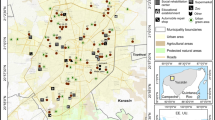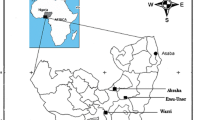Abstract
The Western part of the “Bassin Minier de Provence”, a former coal mining area, is still occupied by old polluting industries such as a coal-fired power plant and an alumina factory. The identified pollution sources that raise more concern in the population are the emission of gases and dusts, as well as the storage of raw and transformed materials. In 2011, a preliminary survey was carried out in the area as the first step to an exposure and health risk-assessment study. This first survey intends to assess human exposure through ingestion and health risk associated with potentially harmful elements (PHEs) in ground-level dusts collected in recreational areas used by children. Dust samples were taken at 19 sites distributed across the study area, depending on the location of public parks, public gardens, playgrounds and schools. Pseudo-total concentrations of 53 elements were determined by ICP-MS. Bioaccessible concentrations were estimated using the unified bioaccessibility method. This study presents the results obtained for Al, V and Cr, which seem to be related with industry and show similar distribution patterns. PHEs presumably related to traffic or other urban pollution sources are not discussed in this study. The highest total concentrations occur in dusts near the alumina plant that have significant amounts of Al mineral phases (gibbsite and alumina). However, in these dusts only small fractions of the elements under study are in bioaccessible forms. The highest bioaccessible fractions occur in dusts collected near the coal-fired power plant. Further investigation is required to assess potential pathways of exposure and health risk in this area.









Similar content being viewed by others
References
Bacigalupo, C., & Hale, B. (2012). Human health risks of Pb and As exposure via consumption of home garden vegetables and incidental soil and dust ingestion: A probabilistic screening tool. Science of the Total Environment,. doi:10.1016/j.scitotenv.2012.01.057.
Beauchemin, S., MacLean, L. C. W., & Rasmussen, P. E. (2011). Lead speciation in indoor dust: A case study to assess old paint contribution in a Canadian urban house. Environmental Geochemistry and Health,. doi:10.1007/s10653-011-9380-8.
Calabrese, E. J., Stanek, E. J., & Barnes, R. (1996). Methodology to estimate the amount and particle size of soil ingested by children: Implications for exposure assessment at waste sites. Regulatory Toxicology and Pharmacology, 24, 264–268.
Chitambar, C. R. (2010). Medical applications and toxicities of gallium compounds. International Journal of Environmental Research and Public Health,. doi:10.3390/ijerph7052337.
Costa, C., Reis, A. P., Ferreira da Silva, E., Rocha, F., Patinha, C., Dias, A. C., et al. (2012). Assessing the control exerted by soil mineralogy in the fixation of potentially harmful elements in the urban soils of Lisbon, Portugal. Environmental Earth Sciences,. doi:10.1007/s12665-011-1362-8.
Cui, Y., Fu, J., & Chen, X. (2011). Speciation and bioaccessibility of lead and cadmium in soil treated with metal-enriched Indian mustard leaves. Journal of Environmental Sciences,. doi:10.1016/S1001-0742(10)60456-1.
DeKom, J. F. M., Dissels, H. M. H., Van DerVoet, G. B., & De Wolff, F. A. (1997). Serum aluminium levels of workers in the bauxite mines. Clinical Toxicology,. doi:10.3109/15563659709001248.
Fritschi, L., de Klerk, N., Sim, M., Benke, G., & Musk, A. W. (2001). Respiratory morbidity and exposure to bauxite, alumina and caustic mist in alumina refineries. Journal of Occupational Health, 43, 231–237.
Girouard, E., & Zagury, G. J. (2009). Arsenic bioaccessibility in CCA-contaminated soils: Influence of soil properties, arsenic fractionation, and particle-size fraction. Science of the Total Environment,. doi:10.1016/j.scitotenv.2008.12.019.
Hachimi, A., Van Vaeck, L., Poels, K., Adams, F., & Muller, J. F. (1998). Speciation of chromium, lead and nickel compounds by laser microprobe mass spectrometry and application to environmental and biological samples. Spectrochimica Acta Part B: Atomic Spectroscopy, 53, 347–365.
Hamula, C., Wang, Z., Zhang, H., Kwon, E., Xing-Fang, L., Gabos, S., et al. (2006). Chromium on the hands of children after playing in playgrounds built from chromated copper arsenate (CCA)-treated wood. Environmental Health Perspectives, 114, 460–465.
Han, Y., Cao, J., Posmentier, E. S., Fung, K., Tian, H., & An, Z. (2008). Particulate-associated potentially harmful elements in urban road dusts in Xi’an, China. Applied Geochemistry,. doi:10.1016/j.apgeochem.2007.09.008.
Harford, A. J., Hogan, A. C., Tsang, J. J., Parry, D. L., Negri, A. P., Adams, M. S., et al. (2010). Effects of alumina refinery wastewater and signature metal constituents at the upper thermal tolerance of: 1. The tropical diatom Nitzschia closterium. Science of the Total Environment,. doi:10.1016/j.scitotenv.2009.10.075.
Huggins, F. E., Seidu, L. B. A., Huffman, G. P., Honaker, R. Q., Kyger, J. R., Higgins, B. L., et al. (2009). Elemental modes of occurrence in an Illinois #6 coal and fractions prepared by physical separation techniques at a coal preparation plant. International Journal of Coal Geology,. doi:10.1016/j.coal.2008.10.002.
Ilander, A., & Väisänen, A. (2009). The determination of trace element concentrations in fly ash samples using ultrasound-assisted digestion followed with inductively coupled plasma optical emission spectrometry. Ultrasonics Sonochemistry,. doi:10.1016/j.ultsonch.2009.03.001.
Juhasz, A. L., Weber, J., & Smith, E. (2011). Impact of soil particle size and bioaccessibility on children and adult lead exposure in peri-urban contaminated soils. Journal of Hazardous Materials,. doi:10.1016/j.jhazmat.2010.12.095.
Kabata-Pendias, A. (2001). Trace elements in soils and plants (3rd ed.). USA: CRC Press.
Kwon, E., Zhang, H., Wang, Z., Jhangri, G. S., Lu, X., Fok, N., et al. (2004). Arsenic on the hands of children after playing in playgrounds. Environmental Health Perspectives, 112, 1375–1380.
Meunier, L., Koch, I., & Reimer, K. J. (2011). Effect of particle size on arsenic bioaccessibility in gold mine tailings of Nova Scotia. Science of the Total Environment,. doi:10.1016/j.scitotenv.2011.02.006.
Meyer-Baron, M., Schäper, M., Knapp, G., & van Thriel, C. (2007). Occupational aluminum exposure: Evidence in support of its neurobehavioral impact. Neurotoxicology,. doi:10.1016/j.neuro.2007.07.001.
Noack, Y., Leoni, C., Robert, S., Reis, A. P., Patinha, C., Fleury, J. (2012). Tree leaves used as indicators of dispersion of particulate atmospheric pollution. Book of Abstracts of the 9th ISEG-International Symposium on Environmental Geochemistry (pp. 250–251). July 15–21, Aveiro, Portugal.
Oomen, A. G., Hack, A., Minekus, M., Zeijdner, E., Schoeters, G., Verstraete, W., et al. (2002). Comparison of five in vitro digestion models to study the bioaccessibility of soil contaminants. Environmental Science and Technology,. doi:10.1021/es010204v.
Pontes, F. V. M., Mendes, B. A. O., de Souza, E. M. F., Ferreira, F. N., da Silva, L. I. D., Carneiro, M. C., et al. (2010). Determination of metals in coal fly ashes using ultrasound-assisted digestion followed by inductively coupled plasma optical emission spectrometry. Analytica Chimica Acta,. doi:10.1016/j.aca.2009.11.055.
Rasmussen, P. E., Subramanian, K. S., & Jessiman, B. J. (2001). A multi-element profile of house dust in relation to exterior dust and soils in the city of Ottawa, Canada. Science of the Total Environment, 267, 125–140.
Reimann, C., & de Caritat, P. (1998). Chemical elements in the environment: factsheets for the geochemical and environmental scientist. Berlin: Springer.
Reis, A. P., Patinha, C., Ferreira da Silva, E., & Sousa, A. J. (2012). Metal fractionation of cadmium, lead and arsenic of geogenic origin in topsoils from the Marrancos gold mineralisation, northern Portugal. Environmental Geochemistry and Health,. doi:10.1007/s10653-011-9433-z.
Ruby, M. V., Schoof, R., Brattin, W., Goldade, M., Post, G., Harnois, M., et al. (1999). Advances in evaluating the oral bioavailability of inorganics in soil for use in human health risk assessment. Environmental Science and Technology,. doi:10.1021/es990479z.
Salminen, R., Batista, M. J., Demetriades, A., Lis, J., & Tarvainen, T. (2005). Sampling. In R. Salminen (Ed.), Geochemical atlas of Europe. Part 1: Background information, methodology and maps. Espoo: Geological Survey of Finland.
Schumacher, B. A. (2002). Methods for the determination of total organic carbon (TOC) in soils and sediments. Washington, DC: U.S. Environmental Protection Agency. EPA/600/R-02/069 (NTIS PB2003-100822).
Senior, C. L., Bool, L. E., I. I. I., Srinivasachar, S., Pease, B. R., & Porle, K. (2000). Pilot scale study of trace element vaporization and condensation during combustion of a pulverized sub-bituminous coal. Fuel Processing Technology, 63, 149–165.
Smołka-Danielowska, D. (2006). Heavy metals in fly ash from a coal-fired power station in Poland. Polish Journal of Environmental Studies, 15, 943–946.
Wragg, J., Cave, M., Basta, N., Brandon, E., Casteel, S., Denys, S., et al. (2011). An inter-laboratory trial of the unified BARGE bioaccessibility method for arsenic, cadmium and lead in soil. Science of the Total Environment,. doi:10.1016/j.scitotenv.2011.05.019.
Wragg, J., Cave, M., & Nathanail, P. (2007). A study of the relationship between arsenic bioaccessibility and its solid-phase distribution in soils from Wellingborough, UK. Journal of Environmental Science and Health Part A,. doi:10.1080/10934520701436062.
Xu, M., Yan, R., Zheng, C., Qiao, Y., Han, J., & Sheng, C. (2003). Status of trace element emission in a coal combustion process: A review. Fuel Processing Technology,. doi:10.1016/S0378-3820(03)00174-7.
Yalçin, N., & Sevinc, V. (2000). Utilization of bauxite waste in ceramic glazes. Ceramics International, 26, 485–493.
Zagury, G. J., Samson, R., & Deschênes, L. (2003). Occurrence of metals in soil and ground water near chromated copper arsenate-treated utility poles. Journal of Environmental Quality, 32, 507–514.
Acknowledgments
The authors acknowledge the Labex DRIIHM and the Réseau des Observatoire Hommes-Millieux-Centre National de la Recherche Scientifique (ROHM-CNRS) for the support to the project “Analyse comparée de la perception de la pollution atmosphérique en milieu urbain et industriel: Société, géochimie et analyse spatial”, and the Foundation for Science and the Technology (FCT) for the support to the project PEst-C/CTE/UI4035/2011. The authors also want to express their gratitude to the anonymous reviewers for their helpful comments that significantly improved the paper.
Author information
Authors and Affiliations
Corresponding author
Rights and permissions
About this article
Cite this article
Reis, A.P., Patinha, C., Noack, Y. et al. Assessing human exposure to aluminium, chromium and vanadium through outdoor dust ingestion in the Bassin Minier de Provence, France. Environ Geochem Health 36, 303–317 (2014). https://doi.org/10.1007/s10653-013-9564-5
Received:
Accepted:
Published:
Issue Date:
DOI: https://doi.org/10.1007/s10653-013-9564-5




